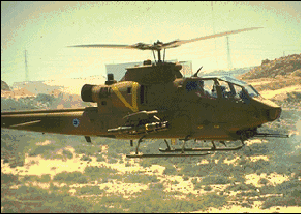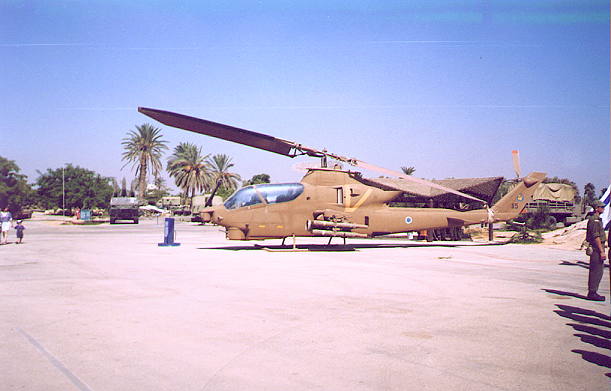
The attack helicopter concept was born in the mid 1960s when the need for an armed escort helicopter became apparent. By 1965, when the U.S. army had issued a requirement for an aerial fire support system, Bell had already devised its own private venture offering by designing a gunship version of its UH-1 Huey. The new helicopter incorporated the proven engine, transmission and rotor of the UH-1 but featured a new fuselage, a two seat cockpit for the gunner (front) and pilot (rear), stub wings and a chin mounted machine gun turret. The AH-1 flew for the first time on Sptember 7th 1965 and was ordered into production on April 9th 1966. Within 18 months the initial model, the AH-1G, was in service in Vietnam. Later variants include the AH-1Q, the first TOW anti-tank missile armed variant, and the AH-1S with improved engine and avionics and equipped with fire control and navigation systems.
The traumatic Yom Kippur War of October 1973 provided the IAF with the incentive to procure attack helicopters of its own. The IDF had initialy failed in halting the Syrian armoured assault on the Golan Heights and the Egyptian crossing of the Suez Canal, while the dense Arab air defences proved a deadly hindrance to IAF operations. Attack Helicopters could provide answers to both of these problems and when the IAF begun a heavy procurement program after the war, attack helicopters were high on its shopping list. In May 1974 four pilots journeyed to the USA in order to evaluate the different options available to the IAF in choosing its new helicopter. The pilots had flown the Cobra but were more impressed by the Sikorsky S-67 Blackhawk, still in the experimental stage. The S-67 deal however, fell through when the prototype crashed and the IAF opted for the AH-1 instead. The IAF procured six AH-1Gs from US Marines surplus and shortly later the first Israeli pilots arrived in the USA to undergo a six weeks conversion course.
In order to study the basics of helicoper warfare and its implications on the battlefield, the IAF formed an experimental squadron into which the Cobras were incorporated. The six AH-1Gs arrived in Israel in April 1975, and a first flight in Israeli skies took place a month later. A subsequent 8 months evaluation period ended with the filing of a very favourable report to the IAF commander, Benny Peled. The IAF quickly adopted the report's recommendations which included the upgrade of all AH-1Gs to AH-1Q statndard and the procurement of more AH-1s.
 Implementation of the report also called for the Cobra expermintal unit to transform into the first IAF
Cobra squadron and December 1977 saw the formation of the "Shfifon Tzahov" (Yellow Viper) squadron. Training at the squadron commenced with three Bell 206s as all the AH-1s had been shipped back to the USA in May in
order to undergo their upgrades. The first upgraded Cobra arrived back in Israel in August 1978 and the type was awarded the nicknamed "Tzefa" (Viper).
Implementation of the report also called for the Cobra expermintal unit to transform into the first IAF
Cobra squadron and December 1977 saw the formation of the "Shfifon Tzahov" (Yellow Viper) squadron. Training at the squadron commenced with three Bell 206s as all the AH-1s had been shipped back to the USA in May in
order to undergo their upgrades. The first upgraded Cobra arrived back in Israel in August 1978 and the type was awarded the nicknamed "Tzefa" (Viper).
Since the mid-1970s Lebanon has been Israel's most active front, with fighting still taking place on a daily basis. The attack helicopter's unique abilities and its precision weapons have made it perfect
for the Lebanese theatre and IAF Cobras have been a constant feature of the fighting for more than 20 years.
The first Cobra attack took place on May 9th 1979, against a terrorist structure located inside a refugee
camp near Tyre. The Cobra squadron had deployed to southern Israel but upon receiving its combat order dispatched its helicopters back to their base in central Israel. Having crossed the Israeli-Lebanese border over
the Mediterranean at dusk, two AH-1s scored direct hits with 2 missile fired by each helicopter. The successful outcome of the attack pushed the type into the forefront of Israeli activity in Lebanon ever since.
The IAF's attack helicopters, AH-1 Cobras as well as MD.500 Defenders, saw a great deal of activity throughout operation "Peace for Galilee", Israel's invasion of Lebanon in June 1982. The Cobras were the first IAF helicopters to go into action on June 6th, their first attack mission involving the destruction of a radar station, although later targets included armour, artillery, anti aircraft artillery and more. Tasked with providing close support to Israeli ground forces, the initial days of the war saw repeated attacks against Palestinian forces and positions in south Lebanon. Until the Syrian air defence array in the eastern Bekaa Valley was destroyed on June 9th, Cobras operated mainly in the western frontier of the fighting, close assistance also given to the Israeli ground forces landing from the sea north of the Alawi River outlet.
When Syria entered the fighting on June 9th, the Cobras were turned against the Syrian military. Cobras engaged and destroyed dozens of Syrian tanks, including T-72s, the most advanced Soviet tank of the time. One attack even involved the destruction of an entire Syrian armour brigade deep behind Syrian lines: AH-1s attacked and destroyed its tanks on board train cars, about to carry them to the front! Two Cobras were lost during the war. One was hit by 23mm anti aircraft fire on June 6th and crashed, killing both pilots. Another Cobra was hit during the fighting and its crew was rescued. A Sikorsky CH-53 carrying the stricken aircraft back to Israel was forced to throw it into the sea after suffering from severe vibrations.
 After the end of the war, with the Cobra once again having proven its worth, the IAF purchased another batch of AH-1s, the second Cobra squadron formed in 1985.
The Israeli presence inside Lebanon required close Cobra support, difficult to maintain from the squadron's central Israel base. While at first Cobras operated from a site near the Lebanese city of Sidon, the Israeli withdrawl from Lebanon in 1985 prompted the formation of a new base in northern Israel, inaugurated in April 1985. Besides making the Cobras more available, the new site also formally placed command of the Cobras under Israel's Northern Command, thus providing a more direct link between operational needs and the Cobra crews, shortening Cobra response times.
After the end of the war, with the Cobra once again having proven its worth, the IAF purchased another batch of AH-1s, the second Cobra squadron formed in 1985.
The Israeli presence inside Lebanon required close Cobra support, difficult to maintain from the squadron's central Israel base. While at first Cobras operated from a site near the Lebanese city of Sidon, the Israeli withdrawl from Lebanon in 1985 prompted the formation of a new base in northern Israel, inaugurated in April 1985. Besides making the Cobras more available, the new site also formally placed command of the Cobras under Israel's Northern Command, thus providing a more direct link between operational needs and the Cobra crews, shortening Cobra response times.
While on a training flight on October 21st 1985, an AH-1 slammed into the Sea of Galilee. Landing nearby, the crew of the other Cobra rescued the two pilots caught in the wreckage, earning theselves a citation from IAF Commander, Amos Lapidot. Although Cobra 489 was heavily damaged the IAF nonetheless decided to repair it, a process which took five years and ended with the helicopter's return to service (picture on the left).
On October 16th 1986 an IAF Phantom attacking Palestinian targets in Lebanon suffered from a malfunction in its bomb release mechanism, forcing its two crew members to eject. The navigator, Ron Arad, was captured by Palestinians and has been held in captivity ever since, but the pilot of the downed aircraft managed to elude captivity. IAF aircraft which attempted to reach his position were fired upon by terrorists on the ground, hampering rescue attempts. A pair of AH-1s nonetheless managed to reach the pilot and hanging on to a Cobra's skid, the pilot was carried all the way back to Israel. A similar rescue took place on December 9th 1988 after a number of IDF soldiers were stranded in Lebanon following operation "Kahol ve-Hoom" (blue and brown). The joint Navy and Golani infantry raid against a PFLP (Popular Front for the Liberation of Palestine) headquarter deep in Lebanon, in which AH-1s also participated, had ended successfully but for 4 IDF soldiers missing somewhere on the ground. Once contact was made with the missing squad, IAF fighter bombers kept Palestinian forces from reaching the stranded soldiers, enabling a rescue attempt. The close proximity of the terrorists however, prevented rescue helicopters from landing and the Cobras were sent in instead. Under heavy fire, a pair of Cobras descended towards the stranded soldiers and carried them on their skids to Navy boats off the Lebanese coast. The four Cobra crew members which had performed the rescue received citations from the IDF Chief-of-Staff.
On May 30th 1990 Israel Navy boats spotted an unidentified boat attempting to infiltrate Israeli waters and reach the shore. The fastboat managed to elude the Navy ships but an IAF Do-28 Agur tracked the boat to the beach at Nitzanim in southern Israel and launched Cobras to intercept it. The Agur pilot then flew low passes over the boat in order to prevent it from landing until the AH-1s arrived. When the boat, carrying PLO terrorists about to strike at Israel, finally managed to land the Cobras were on the scene to halt the passengers from getting off the beach and allowed IDF forces to surround the area. Most of the terrorists finally surrendered although some were killed, at least one by a Cobra's cannon fire.

As part of their routine service in southern Lebanon the Cobras were also very active in Israel's two major operations against Hizbullah guerrillas, operations "Accountability" and "Grapes of Wrath". The later, carried out during April 1996 saw around-to-clock Cobra activity, seeking and destroying Katyusha rocket launchers directed against northern Israel as well as attacking enemy positions throughout southern Lebanon. The first three days saw over 150 attack sorties, while during the entire week long operation 90 targets were attacked with 170 anti tank missiles.
IAF Cobras have seen various upgrades throughout their history, the current IAF helicopter force fully capable of carrying nocturnal operations. Much of the upgraded avionics have been desgined by local Israeli industries, including their weapon guidance systems. In November 1996 the IAF received additional AH-1Es from USAF surplus. Although some helicopters were put into service with the two Cobra squadrons, others joined the IAF Flight School where they train future attack helicopter pilots. Unlike standard Cobras which carry desert camouflage, flight school Cobras carry an all black livery. One Cobra also resides in the IAF Museum in Hatzerim (picture above). This is one of the original six AH-1Gs supplied to Israel, identified by their buldging canopies absent on later examples.
 back to the IDF/AF page
back to the IDF/AF page